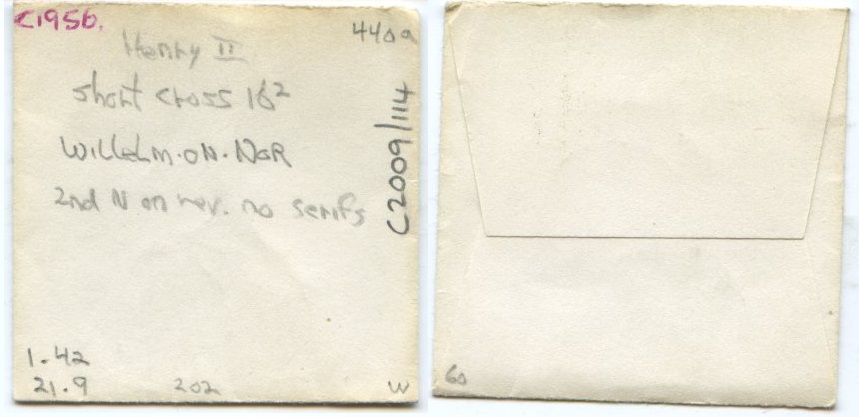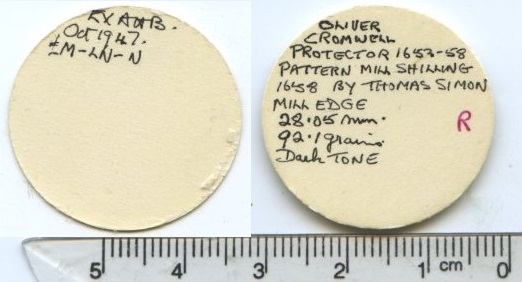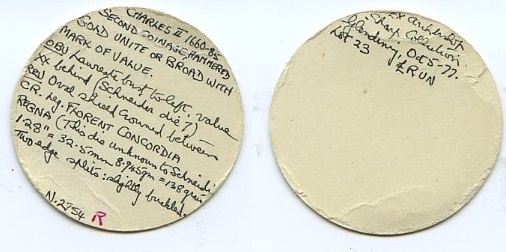-
Posts
12,746 -
Joined
-
Last visited
-
Days Won
339
Content Type
Profiles
Forums
Events
Downloads
Store
Gallery
Articles
Everything posted by Rob
-
It varies. For Saxon pennies, North unhelpfully states 'Probably several standards' based on the wide divergence of weights without giving an opinion. Blunt, Stewart & Lyon suggest a figure of 24 grains for Alfred's later coins, reducing gradually to 20 grains by the time of Eadgar's reform. There are regional variations in the observed weights from different areas, so maybe North's statement is as close as you can get. Later Saxon average weights also vary across large sample populations, so it is likely that either any existing standard wasn't adhered to, or the weight of pennies reflected the economics of the time. I don't have the answer. There are two pairs of figures which might be significant. Both Aethelred's LSC and Edward the Confessor's Expanding cross have light and heavy issues, the heavier of which is on average 50% higher. That seems awfully convenient and may be accounting related. Could it be related to the Mark? I'm not sure when that was introduced as an accounting tool, but the pound and mark are in the same 3:2 ratio. For Norman pennies, Hawkin (p.7) gives a figure of 22.5 grains for William I. North (p.257) gives 22 grains for William II to Henry III
-
It's normal. 5 pences were struck from 1968 onwards in preparation for decimalisation and stockpiled. If the detail is not clear, it will be worn and of no value over scrap
-
Just the engineering tolerances will produce 'varieties' within those limits. The question is, at what point are these limits exceeded, and even then, is the difference due to an out of tolerance component? These would still not be an error in my view, as wear and tear will increase the size of any gaps leading to an increasingly sloppy fit. They will stop using the die or collar once it is broken or obviously causing faulty strikes. I would suggest it is a fairly inexact science to determine at what point these could even be considered as an error. Same goes for die fill. Not in the original design, but not an error once it happens.
-
I don't think the shape of the blanks is an issue because the 'corners' on the edge always correspond to the same point on the design to within a midge's. These are a full milled/blank section out. It is quite possible that the position of the edge milling was intended to be a security feature and that this is an error. Or could the collar be put on upside down, as this would produce the same effect?
-
Journalism is nearly always a case of 'me too' reporting. There aren't enough stories of interest to go round, so one paper's scoop is often a different version another paper's scoop. The tabloids do better simply because they widen their net to include the ever vacuous and irrelevant celebrity 'news'. Also, if in doubt, make it up. Anyway, the news about the 2016 pound must be right as it was printed in a respectable 'newspaper'
-
The relief looks a bit high for a struck piece. It could well be a cast.
-
Whereabouts are you? There are a few dealers on here spread across the country, so you might find someone near you to help. You will get an honest appraisal. I will declare a vested interest here - I'm in Manchester, but obviously not necesssarily the closest. Argentum is in the North-East and there are a number down south who you could be directed to. Chris, the forum owner is also a dealer but lives in Germany, so it might be a while before he visits, but he is otherwise in the SE London/Kent area.
-
Mine says the opposite. Can't live like this with you, can't live like this with you......... Never seem to notice problems like this building up. I'm not the sharpest tool in the box on the emotion front, so someone else will have to accommodate this.
-

Cope and Raynor Errors?
Rob replied to DaveG38's topic in British Coin Related Discussions & Enquiries
It has to be a mistake. I don't know what the printing technique used at that time, but if it was a case of assembling words in blocks and dropping them in, then it would be normal to pull out farthings and drop halfpennies into the vacant spots. There was only one print run. -
The last digit, or the last two digits were entered by hand. As a result the date can appear wide or narrow. That was made from a 186 master, but some are only 18.
-
Nothing wrong that I can see, though no reverse image. Why would you think it wrong?
-
Difficult to say. A picture rarely conveys the same impression as something in hand. But there are clear lines on the obverse, hence the assessment.
-
Looking at the obverse it has been wiped
-
Don't shout too loud chaps. I've had it pointed out that I could have bought more than the odd kitchen in the past few years.
-
I'm not sure Mrs N would have appreciated being thought of as something servicing the whole of the north west of the UK.
-
Not as far as I am aware.
-
Its an old turd as far as you have been told. You don't know, and nor do I. Have to question everything until you are happy in your own mind of the arguments for and against. Now, what are the dimples running along the middle line of said exhibit?
-
I know you claim it is coprolite and I know of this, but what are the dimples resembling a fish's lateral line? Don't tell me they are skewer marks from a prehistoric hot dog fresh off the BBQ as I won't believe you. I wouldn't expect to see regular features on any turd, new or old.
-

Very Old 1912 Penny
Rob replied to singlemom29's topic in British Coin Related Discussions & Enquiries
1920 to1946 silver is 500 silver & silver coins up to 1919 are 925 silver. Silver coins from 1947 onwards aren't. Scrap bronze or cupro-nickel is effectively worth scrap copper price. If they are in better condition they might be worth more. You'll have to post some images to give us an idea. -

Large Bag of 1967 Half Pennies
Rob replied to JACGW's topic in British Coin Related Discussions & Enquiries
In a way it would be good if the mint would take them back as it is surely an alloy mix they use to this day, but if you tried to cash them in at the BoE then you would only get face instead of their intrinsic value. -

Very Old 1912 Penny
Rob replied to singlemom29's topic in British Coin Related Discussions & Enquiries
Try soap and water with a soft brush if it is dirt. Don't scrub it or use a hard abrasive of any description and pat dry with a soft towel. -

Large Bag of 1967 Half Pennies
Rob replied to JACGW's topic in British Coin Related Discussions & Enquiries
Melt value. There are countless bags of 1967 coins of all denominations lying around with probably millions of coins still sitting there. -
SAZAMA, J Jim Sazama's collection of medieval coins was sold through DNW over many sales from 2011 onwards. Some coins had 24mm tickets with sparse detail, but all coins were in envelopes with description, weight in grams and grains, and what was presumably the cost on the back. All written in pencil.
-
BRADY, F Frank Brady's collection of groats was sold at Spink in October 2011. There were no Brady tickets, only those of previous owners or dealers, the coins being held in 2x2 paper envelopes with the North reference written on.
-
PARSONS, O F Collection sold by Baldwin in May 1997 (sale 12). White tickets 29mm dia in the case of the first. Not sure about the diameter of the second. Description on one side, provenance and cost code on the other.





